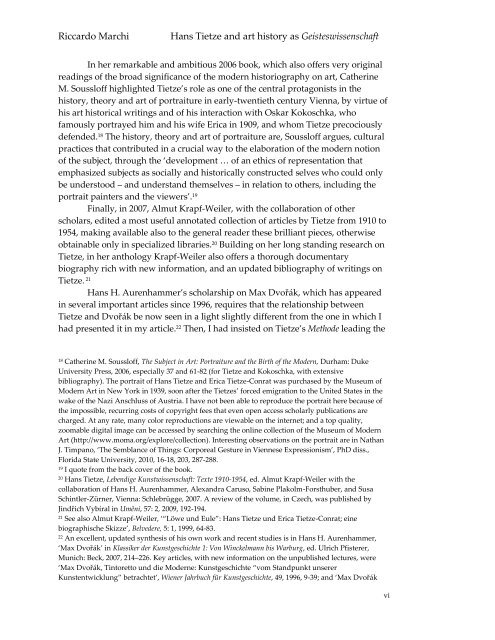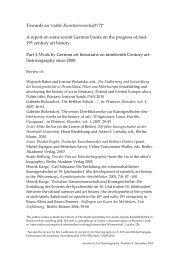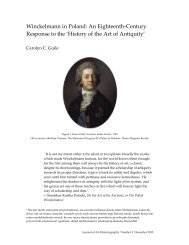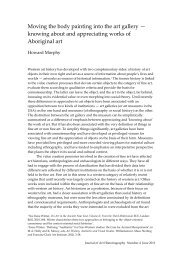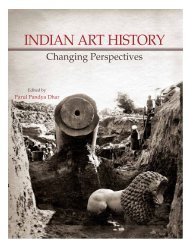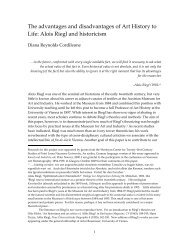Geisteswissenschaft - Journal of Art Historiography
Geisteswissenschaft - Journal of Art Historiography
Geisteswissenschaft - Journal of Art Historiography
You also want an ePaper? Increase the reach of your titles
YUMPU automatically turns print PDFs into web optimized ePapers that Google loves.
Riccardo Marchi Hans Tietze and art history as <strong>Geisteswissenschaft</strong><br />
In her remarkable and ambitious 2006 book, which also <strong>of</strong>fers very original<br />
readings <strong>of</strong> the broad significance <strong>of</strong> the modern historiography on art, Catherine<br />
M. Soussl<strong>of</strong>f highlighted Tietze’s role as one <strong>of</strong> the central protagonists in the<br />
history, theory and art <strong>of</strong> portraiture in early-twentieth century Vienna, by virtue <strong>of</strong><br />
his art historical writings and <strong>of</strong> his interaction with Oskar Kokoschka, who<br />
famously portrayed him and his wife Erica in 1909, and whom Tietze precociously<br />
defended. 18 The history, theory and art <strong>of</strong> portraiture are, Soussl<strong>of</strong>f argues, cultural<br />
practices that contributed in a crucial way to the elaboration <strong>of</strong> the modern notion<br />
<strong>of</strong> the subject, through the ‘development … <strong>of</strong> an ethics <strong>of</strong> representation that<br />
emphasized subjects as socially and historically constructed selves who could only<br />
be understood – and understand themselves – in relation to others, including the<br />
portrait painters and the viewers’. 19<br />
Finally, in 2007, Almut Krapf-Weiler, with the collaboration <strong>of</strong> other<br />
scholars, edited a most useful annotated collection <strong>of</strong> articles by Tietze from 1910 to<br />
1954, making available also to the general reader these brilliant pieces, otherwise<br />
obtainable only in specialized libraries. 20 Building on her long standing research on<br />
Tietze, in her anthology Krapf-Weiler also <strong>of</strong>fers a thorough documentary<br />
biography rich with new information, and an updated bibliography <strong>of</strong> writings on<br />
Tietze. 21<br />
Hans H. Aurenhammer’s scholarship on Max Dvořák, which has appeared<br />
in several important articles since 1996, requires that the relationship between<br />
Tietze and Dvořák be now seen in a light slightly different from the one in which I<br />
had presented it in my article. 22 Then, I had insisted on Tietze’s Methode leading the<br />
18 Catherine M. Soussl<strong>of</strong>f, The Subject in <strong>Art</strong>: Portraiture and the Birth <strong>of</strong> the Modern, Durham: Duke<br />
University Press, 2006, especially 37 and 61-82 (for Tietze and Kokoschka, with extensive<br />
bibliography). The portrait <strong>of</strong> Hans Tietze and Erica Tietze-Conrat was purchased by the Museum <strong>of</strong><br />
Modern <strong>Art</strong> in New York in 1939, soon after the Tietzes’ forced emigration to the United States in the<br />
wake <strong>of</strong> the Nazi Anschluss <strong>of</strong> Austria. I have not been able to reproduce the portrait here because <strong>of</strong><br />
the impossible, recurring costs <strong>of</strong> copyright fees that even open access scholarly publications are<br />
charged. At any rate, many color reproductions are viewable on the internet; and a top quality,<br />
zoomable digital image can be accessed by searching the online collection <strong>of</strong> the Museum <strong>of</strong> Modern<br />
<strong>Art</strong> (http://www.moma.org/explore/collection). Interesting observations on the portrait are in Nathan<br />
J. Timpano, ‘The Semblance <strong>of</strong> Things: Corporeal Gesture in Viennese Expressionism’, PhD diss.,<br />
Florida State University, 2010, 16-18, 203, 287-288.<br />
19 I quote from the back cover <strong>of</strong> the book.<br />
20 Hans Tietze, Lebendige Kunstwissenschaft: Texte 1910-1954, ed. Almut Krapf-Weiler with the<br />
collaboration <strong>of</strong> Hans H. Aurenhammer, Alexandra Caruso, Sabine Plakolm-Forsthuber, and Susa<br />
Schintler-Zürner, Vienna: Schlebrügge, 2007. A review <strong>of</strong> the volume, in Czech, was published by<br />
Jindřich Vybíral in Umění, 57: 2, 2009, 192-194.<br />
21 See also Almut Krapf-Weiler, ‘“Löwe und Eule”: Hans Tietze und Erica Tietze-Conrat; eine<br />
biographische Skizze’, Belvedere, 5: 1, 1999, 64-83.<br />
22 An excellent, updated synthesis <strong>of</strong> his own work and recent studies is in Hans H. Aurenhammer,<br />
‘Max Dvořák’ in Klassiker der Kunstgeschichte 1: Von Winckelmann bis Warburg, ed. Ulrich Pfisterer,<br />
Munich: Beck, 2007, 214–226. Key articles, with new information on the unpublished lectures, were<br />
‘Max Dvořák, Tintoretto und die Moderne: Kunstgeschichte “vom Standpunkt unserer<br />
Kunstentwicklung” betrachtet’, Wiener Jahrbuch für Kunstgeschichte, 49, 1996, 9-39; and ‘Max Dvořák<br />
vi


